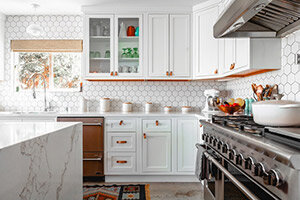
Shifting to a new apartment is always a melting pot of emotions. You’re thrilled, anxious, kind of clueless, and also, kind of relieved.
It’s no mystery that the kitchen is the most important area of a house, second only to the bathroom. Nobody in their right mind should survive on takeaways for eternity. You need to cook your own meal at some point and for that, you need suitable, powerful, versatile weapons.
I have prepared a kitchen essential checklist for you which includes everything you’ll need to get started. These are very basic and will be useful to you regardless of your cooking prowess.
Let’s explore:
Click a link below to jump to the relevant section
Kitchen Knife
Life is too short to prep food with a dull knife. A set of high-quality, sharp knives is the very first thing you need to stock up on for your new kitchen. If you don’t cook a lot or don’t want to invest in a knife set right away, go for an 8-inch chef’s knife or 6-inch santoku knife. It is a multi-utility knife, perfectly suited for cutting meat, dicing, and slicing vegetables. If you feel fancy and have full confidence in your knife skills, go ahead, size up to a 12-inch chef’s knife and knock yourself out.
Cutting Board
Cutting boards don’t get the love and appreciation they deserve. They save you a lot of effort by keeping the counter clean. It doesn’t matter whether you are a hygiene freak or not, you need at least two cutting boards – one for the meat and seafood, another for everything else. Chopping boards can be a warehouse for life-threatening germs and bacteria through cross-contamination. Gross!
Wooden cutting boards are by far the most durable and hygienic material. But they can be expensive. Plastic cutting boards are cheaper and equally safe, even though they don’t look nearly as plush. Bamboo and rubber chopping boards can be good alternatives if you want to try out something unique on a limited budget.
Egg Frying Pan
Eggs are a breakfast staple for the majority of us. Kicking off the day with a cheese and ham omelette or a bacon with sunny side up is sometimes my only motivation to get out of the bed.
If you love eggs just as much as I do, a smooth, non-stick egg pan of the perfect size should be at the very top of your kitchen checklist.
Ideally, the pan should be made of a heat-resistant material like aluminum for even heat distribution. If you have the budget, look for something sturdier like granite-ceramic alloy non-stick pan.
Also check what kind of non-stick coating is used as it will single-handedly determine the shape and taste of your omelette. If the surface is smooth and even, you will be able to flip the omelette effortlessly, which means no more unintentional scrambled eggs. Egg frying pans are also excellent for making pancakes.
Fish Frying Pan
Searing crispy-skinned fish is a delicate job. A few seconds here and there can burn the meat and ruin your dinner. The quality of the pan you use for the job can easily make or break the dish. Speaking from personal experience, you cannot and should not fry fish in just any pan. A heavy-bottomed iron pan is the best gear for the job. Large stainless steel pan is another great option, especially for fattier fishes like salmon and trout.
They heat up steadily and evenly which prevents hotspots. As for the sticking issue, all you have to do is wait till the oil is hot enough before putting the fish in the pan.
Cast Iron Skillet
Heat fluctuation is one of the main culprits behind burnt food. Cast iron skillets are thicker than regular aluminum and Teflon coated pans, making them ideal for foods that need high heat like steak and roasts.
All cuts of beef, pork chops, lamb, and chicken breast brown beautifully on a cast iron skillet. If you don’t want to invest in multiple pans for different cooking purposes, choose a cast iron skillet.
From braising, boiling, roasting, to searing – they can handle any challenge to throw at them. Want to finish off your meal with a simple to make but delicious dessert?
Think skillet chocolate chip cookie topped with a generous helping of vanilla ice cream. Drooling already.
Spatula and Tongs
These two little tools act like an extension of your hands in the kitchen. You’ll need steel spatula for flipping and tossing your eggs, bacon, pancakes, meat, veggies and basically everything.
Don’t forget to buy a set of silicone spatula for your non-stick pans to steer clear of your mom’s wrath. Also add plastic spatula to the list. You will need it for mixing and scraping all the cake batter and cookie dough off your mixing bowls.
Lastly, don’t forget to get a stainless steel tong when you are at it. Tongs are inexpensive and the only acceptable way to handle noodles and pasta. They also make chicken breasts, nuggets, and small chunks of meat easier to maneuver on a sizzling hot pan.
Range hood
Range hood isn’t always the first thing people think about getting when setting up a kitchen. As someone who has triggered the smoke alarm while frying stuff more times than what’s considered acceptable, I’m thankful for this invention. Range hoods suck all the smoke, grease and odor resulting from cooking meals, maintaining a decent air quality not only in the kitchen but in the whole house. Keeping the kitchen with all the grease buildup can be an absolute nightmare without a range hood or ventilation hood. The ventilation it provides is essential to prevent bacteria and mold growth, making it a must-have kitchen gadget for someone with allergies or asthma.
Blender
Juice, milkshake, frappe, detox smoothie, purée, gravy base, freshly ground spice or nuts – a high RPM blender can do almost everything a food processor can. However, grinding dry foods in large batches is not possible with a blender. Also, unlike a food processor, it doesn’t have options for different cutting and grinding sizes. If you need a tool solely for juices, shakes, and puréeing fruits and veggies, a blender will suffice.
Peeler and Grater
I don’t think I know how to cook a savory dish without garlic. My idea of comfort food almost always involves cheese. And on certain occasions, I feel like atoning for my sinful dietary choices by throwing in a bunch of veggies into my meal. A peeler and a grater comes in real handy for tasks like this. They cost nothing and take a lot of chore out of food prepping. That is why no kitchen setup is complete without these two small but extremely useful tools.
In Conclusion
Now that I have chalked out a handy guide to basic kitchen equipment, let’s get cracking.
Of course, you will eventually need more tools as you expand your cooking skills. The tools mentioned above are bare minimums that should be present in every kitchen, whether you are a passionate home cook or a cheetos-gulping bloke who steps into the kitchen only once in a blue moon.
